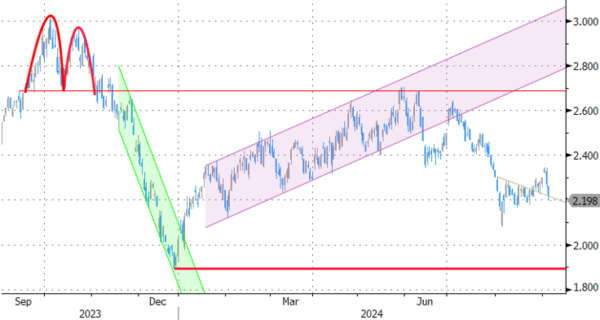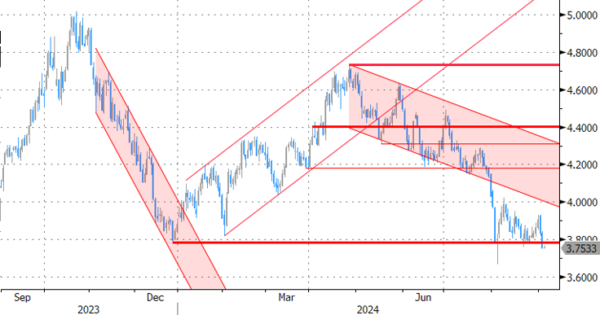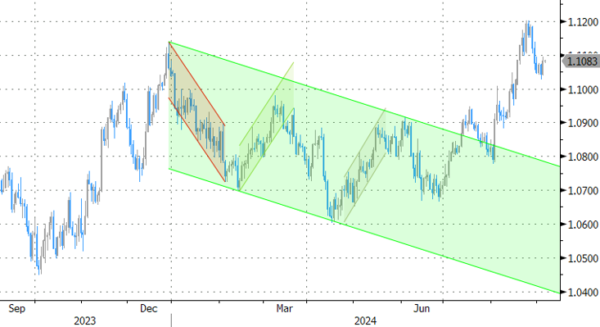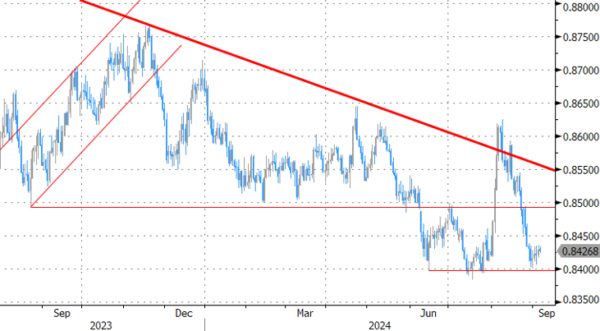Markets
Yesterday’s JOLTS report was yet another perfect illustration of market’s high sensitivity to the labour market since Fed chair Powell bombarded it to the single most important theme for policy. July Job openings in the US tumbled from a downwardly revised 7.94 mln to 7.67 mln, undershooting consensus by about 400k. Resisting the urge for a “jolt(s)”-related pun, it triggered a shock reaction in markets. US yields added to previous losses to the tune of 2 bps to end the day significantly lower: from -6.5 (30-yr) to 10.9 (2-yr) bps. Front-end outperformance resulted from money markets adding to 2024 easing bets. A cumulative 110 bps on the remaining three meetings means that investors are increasingly considering more than one jumbo-sized (50 bps) rate cut. US stock markets hit their intraday highs in the hour after the JOLTS report before paring gains to trade only little changed. The loss of interest rate support weighed on the US dollar. EUR/USD bounced from 1.104 towards 1.108 and the trade-weighted index dropped to 101.36 (from 101.7 at the open). USD/JPY revisited the August sell-off lows around 143.7 on both dollar weakness and JPY strength. The latter extends into Asian dealings this morning after data showed wages in July growing faster than expected. The Bank of Japan’s preferred gauge came in at 4.8% y/y in July. That’s barely slower than June’s 5.1% – which was already boosted by back-pay reflecting this year’s wage negotiations – and significantly more than the 3.2% estimate.
Front-end US yields decisively broke through the recent August lows (eg. 2-yr sub 3.8%). Their technical picture deteriorated significantly as a result. There’s little in the way for a return towards the March 2023 lows seen in the wake of the regional banking crisis in the US (3.55% in the 2-yr yield). A possibly unconvincing ADP job report and/or US August services ISM (expected at 51.4, same as in July) today will undoubtedly add further downward pressure going into tomorrow’s key payrolls release. Longer maturities such as the 10-yr are at a crossroads with the similar August lows barely surviving for the time being. A break lower depends on whether the data is weak enough to reignite recessionary fears. The dollar looks vulnerable nevertheless. EUR/USD 1.1139 serves as a first dollar support.
News & Views
The Bank of Canada yesterday reduced its policy rate for the third consecutive meeting by 25 bps to 4.25%. Q2 growth (2.1%) was slightly stronger than forecast, but preliminary indicators suggest that recent activity was soft. The labour market slows, but wage growth remains elevated relative to productivity growth. Inflation, including underlying measures, declined further in July (2.5%). This allowed for a further easing, with excess supply putting r downward pressure on inflation. High prices for shelter and some services still give some counterweight. At the press conference, Governor Tiff Macklem still advocated data-dependent approach, but also kept the option open for bigger rate cut steps. With inflation getting closer to the target, the BoC needs to increasingly guard against the risk that the economy is too weak and inflation falls too much. The Canada 2-y bond yields yesterday declined 7 bps, but his was also supported by broader (US-driven) market momentum. The market currently fully discounts two additional 25 bps cuts at the October and December meetings and about 30% chance of one bigger move. The Loonie strengthened (USD/CAD 1.35 from 1.355) but this was partially due to overall US weakness.
The Reserve Bank of Australia (RBA) doesn’t join the broader positioning toward (faster) policy easing. In a speech this morning, RBA Governor Michele Bullock reconfirmed bringing inflation to the 2-3% target as the RBA’s priority. “If the economy evolves broadly as anticipated, the board does not expect that it will be in a position to cut rates in the near term,” Bullock said. Inflation cooled to 3.5% but especially domestic inflation from housing and services remains too high. Bullock warned that if high inflation became entrenched in expectations, the RBA would have to slow the economy even more to bring prices back in check, with ultimately a larger rise in unemployment and higher risk of a recession. If circumstances change, the RBA will respond accordingly. The Aussie this morning trades little changed (AUD/USD 0.6725) after having declined earlier this week on lower commodity prices. Markets still see a first RBA rate cut by the turn of the year (December or February meeting).
Graphs
GE 10y yield
The ECB cut policy rates by 25 bps in June and will likely do so again in September. Stubborn inflation (core, services) warrants a cautious approach on follow-up moves. Markets price in two to three more cuts for 2024 as disappointing US and unconvincing EMU activity data rolled in, dragging the long end of the curve down. Yields meanwhile bottomed in the wake of the August market meltdown, preluding a technical correction higher.
US 10y yield
The Fed in its July meeting paved the way for a first cut in September. It turned attentive to risks to the both sides of its dual mandate as the economy is moving to a better in to balance. The pivot weakened the technical picture in US yields. A string of weak eco data pushed and kept the 10-yr sub 4%. Markets increasingly add to 2024 cut bets with more than one jumbo-sized cut gaining traction.
EUR/USD
EUR/USD moved above the 1.09 resistance area as the dollar lost interest rate support at stealth pace. US recession risks and bets on fast and large (50 bps) rate cuts trump traditional safe haven (recessionary) flows into USD. EUR/USD 1.12 was tested but survived. A (technical) dollar comeback had no strong legs. The greenback looks vulnerable.
EUR/GBP
The BoE delivered a hawkish cut in August. Policy restrictiveness will be further unwound gradually on a pace determined by a broad range of data. The strategy similar to the ECB’s balances out EUR/GBP in a monetary perspective. Recent better UK activity data and a cautious assessment of BoE’s Bailey at Jackson Hole are pushing EUR/GBP lower in the 0.84/0.086 range.
















